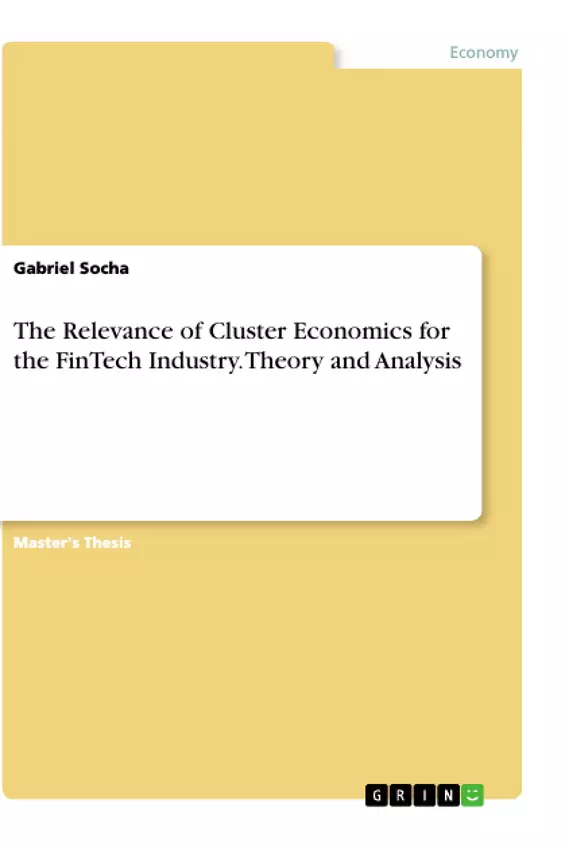This paper is about the relevance of cluster economics for the FinTech industry.
While the FinTech industry overall has experienced strong growth in recent years, the geographical presence of FinTechs is not homogeneously distributed. Instead, it can be observed that certain FinTech hotspots are emerging. Within the political arena there is a discussion about how to make business locations more attractive for the accumulation of FinTechs. In this context the theory of economic clusters must be investigated. What are the underlying factors that contribute to the formation of FinTech clusters?
This paper builds on initial studies on this topic and sheds light on various factors that could be decisive for the agglomeration of FinTechs. Using Michael Porter's Diamond Model, various factors were derived, which were then statistically examined using a data sample for the European Union. The results of the study show that besides the availability of positive externalities, such as specialized talent pools, universities, and accelerators, demand factors such as total market size, internet connectivity, and financial literacy are relevant. Furthermore, the results suggest that the presence of competitors and similar firms, as well as the strength of intellectual property protection laws, are related to the size of FinTech clusters. Based on the results, recommendations for policy makers and FinTech entrepreneurs are provided.
Inhaltsverzeichnis (Table of Contents)
- Introduction
- Literature Review and Theoretical Framework
- FinTech
- Definition
- FinTech Business Segments and Taxonomy
- Economic Clusters
- Theoretical Foundations
- Porter's Diamond Model
- FinTech Clusters
- FinTech
- Qualitative Analysis
- Conceptualization of FinTech Clusters
- Application of Porter's Diamond Model to the FinTech Industry
- Quantitative Analysis
- Overview of Variables and Data Sample
- Regression Models
- Discussion of Results
- Model 1 Factor Conditions
- Model 2 – Demand Conditions
- Model 3 - Related and Supporting Industries
- Model 4 - Strategy, Structure, and Rivalry
- Conclusion
Zielsetzung und Themenschwerpunkte (Objectives and Key Themes)
This paper examines the significance of economic clusters for the FinTech industry. The primary objective is to investigate the factors that contribute to the formation of FinTech clusters and their impact on the industry's growth. The paper builds upon previous research on this topic and provides a comprehensive analysis of the factors that can drive the agglomeration of FinTech companies.
- The emergence and development of FinTech clusters
- The application of Porter's Diamond Model to the FinTech industry
- The role of factors like specialized talent pools, universities, and accelerators in shaping FinTech clusters
- The influence of demand factors, such as total market size and internet connectivity, on FinTech cluster development
- The relationship between competition, intellectual property protection, and the size of FinTech clusters
Zusammenfassung der Kapitel (Chapter Summaries)
The paper begins by introducing the topic of FinTech clusters and highlighting their growing importance within the industry. The literature review provides a theoretical framework by exploring the concept of economic clusters and its relevance to the FinTech industry. The analysis then examines the application of Porter's Diamond Model to the FinTech industry, identifying key factors that contribute to cluster formation. The quantitative analysis utilizes data from the European Union to investigate the relationship between these factors and the size of FinTech clusters. The results of the study reveal the significant influence of factors such as specialized talent pools, demand conditions, and the presence of competitors on the development and growth of FinTech clusters.
Schlüsselwörter (Keywords)
This paper focuses on the core concepts of FinTech clusters, economic agglomeration, and the application of Porter's Diamond Model to the FinTech industry. Key terms and concepts explored in the paper include: FinTech, economic clusters, cluster economics, Porter's Diamond Model, factor conditions, demand conditions, related and supporting industries, strategy, structure, rivalry, talent pools, universities, accelerators, market size, internet connectivity, financial literacy, competition, intellectual property protection.
- Quote paper
- Gabriel Socha (Author), 2020, The Relevance of Cluster Economics for the FinTech Industry. Theory and Analysis, Munich, GRIN Verlag, https://www.grin.com/document/1006271



